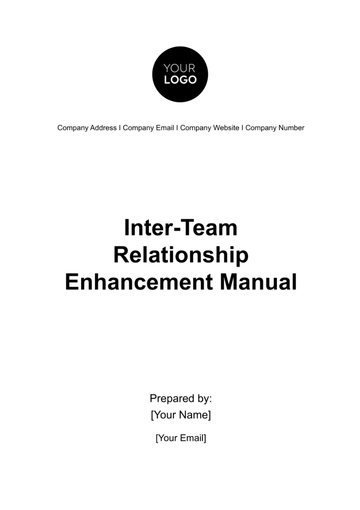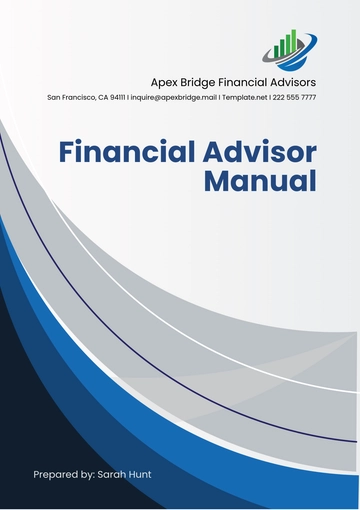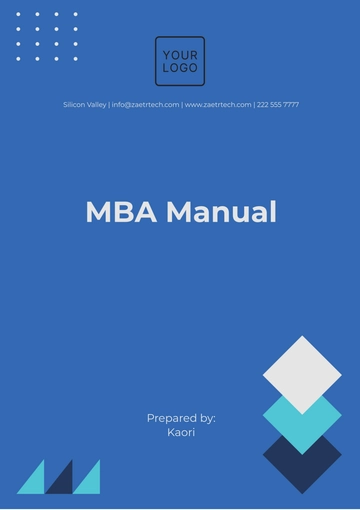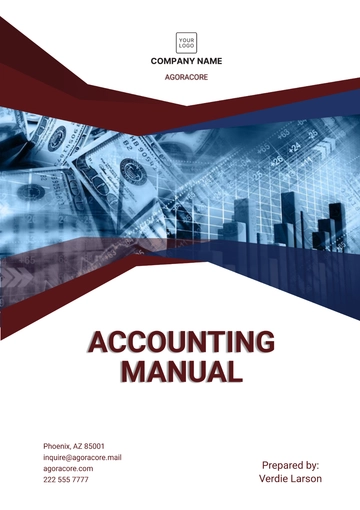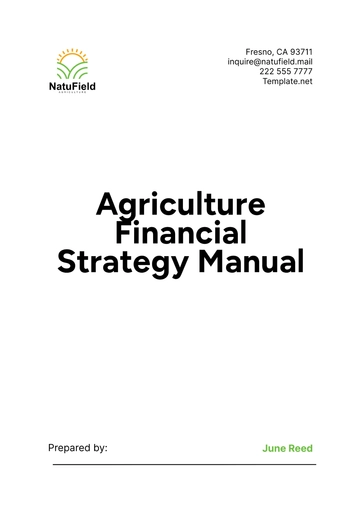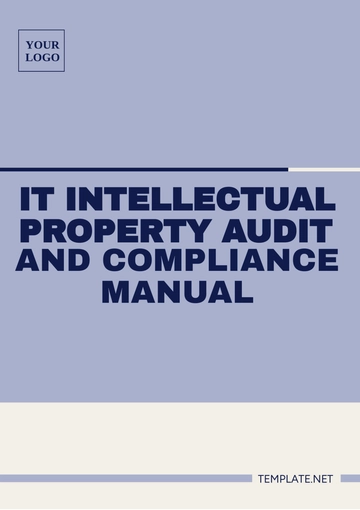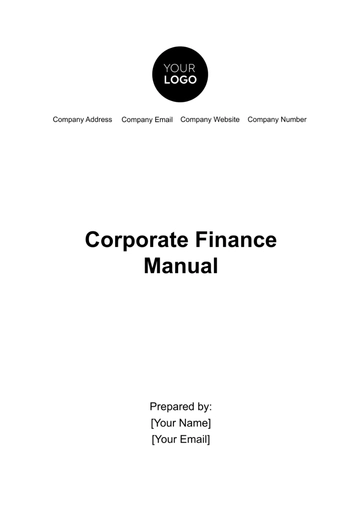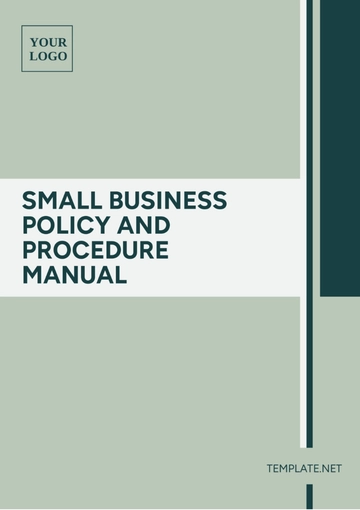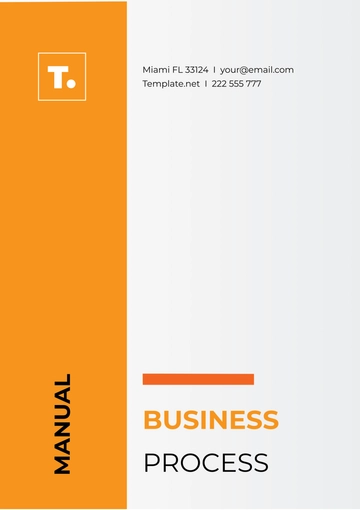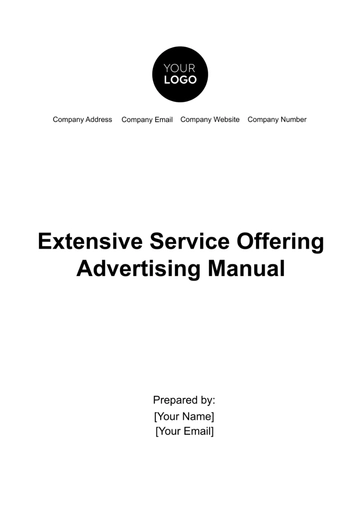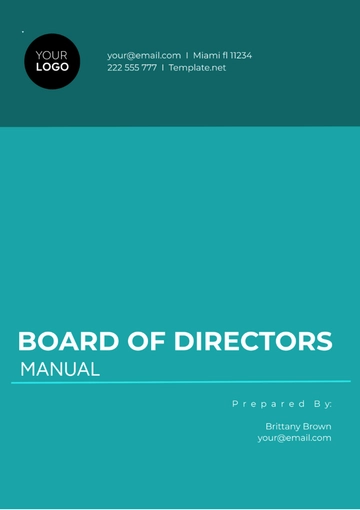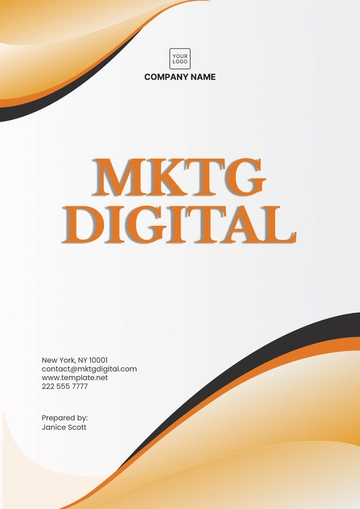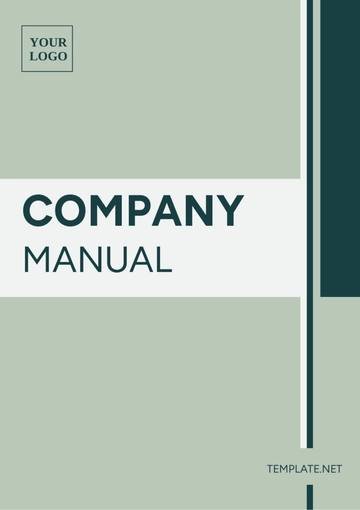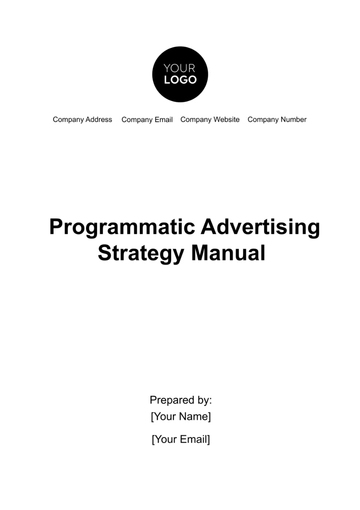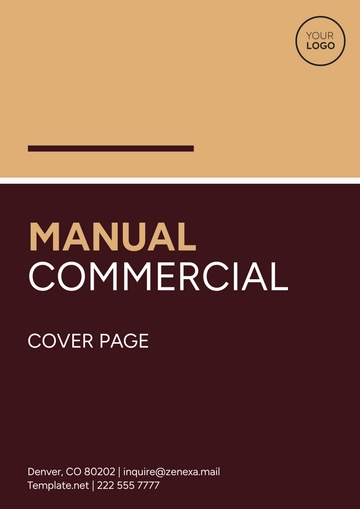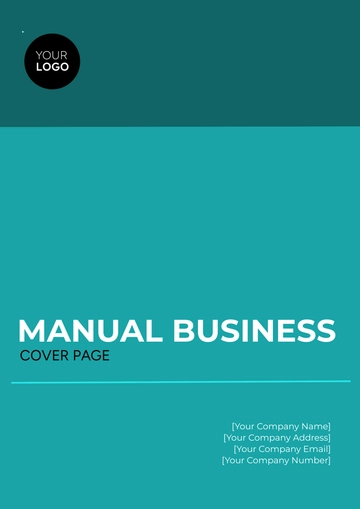Free Corporate Finance Manual
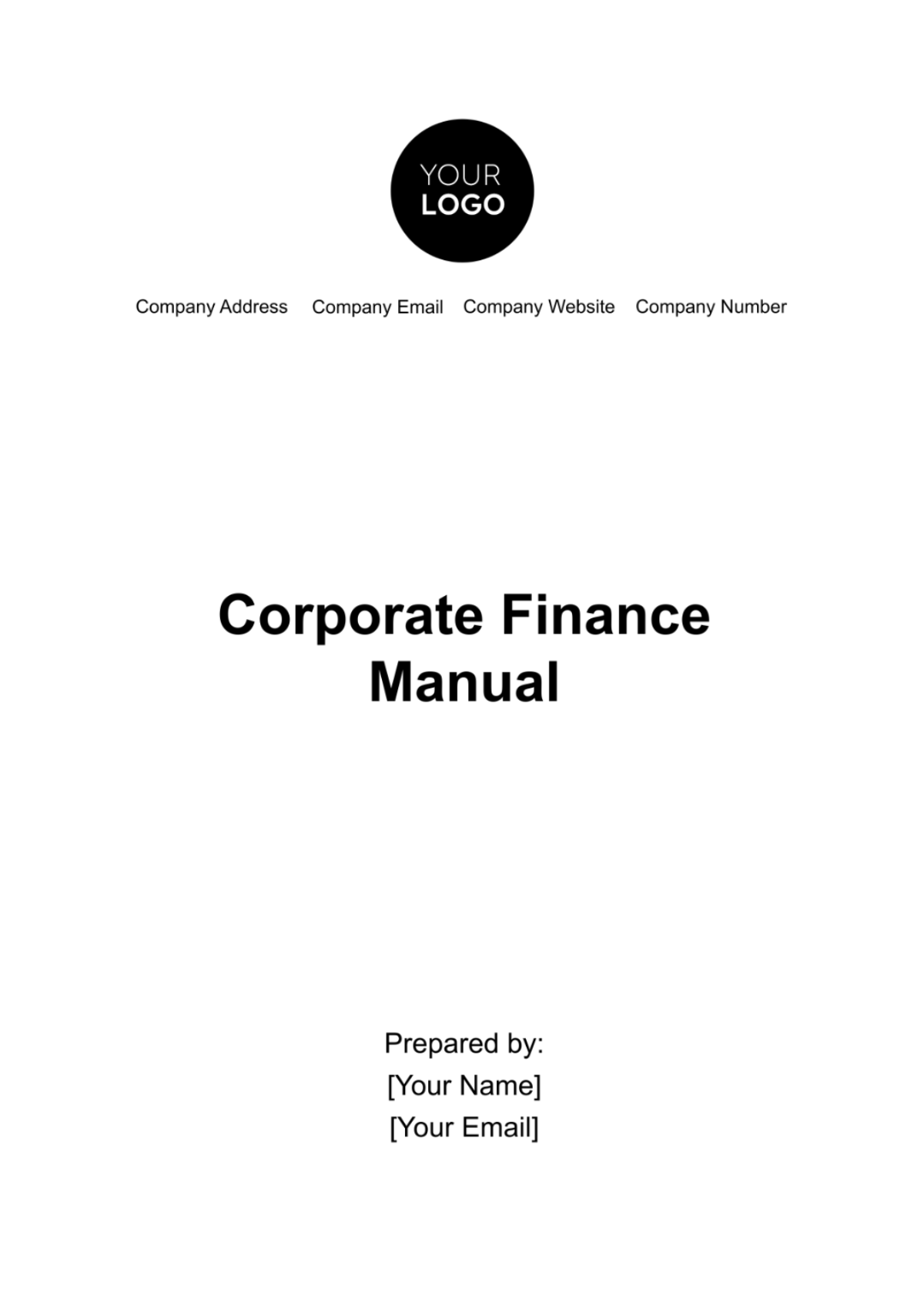
I. Introduction and Overview
This Corporate Finance Manual is an essential guide for [Your Company Name]'s team, offering a comprehensive set of procedures and policies for financial management. It is crafted to foster consistency in financial practices, guarantee adherence to regulatory standards, and drive the optimization of our financial performance. As a cornerstone of our financial governance, this manual is instrumental in aligning daily operations with our broader financial goals, ensuring every team member has a clear, shared understanding of our financial methodologies and objectives.
Scope and Application
This manual encompasses all aspects of financial operations at [Your Company Name], serving as an indispensable resource for employees engaged in financial planning, execution, and reporting. It applies to various departments, including accounting, finance, and any other units dealing with financial transactions or decisions. The contents are designed to be universally applicable across the organization, ensuring a unified approach to financial management that supports both operational efficiency and strategic decision-making.
Financial Philosophy
Our financial philosophy is deeply rooted in the principles of sustainable growth, prudent risk management, and maximization of shareholder value. We strive to balance ambitious financial targets with ethical financial practices, emphasizing long-term stability over short-term gains. Our commitment to this philosophy is reflected in every aspect of our financial decision-making processes, from capital allocation to investment strategies, ensuring that our financial actions consistently support our overarching business objectives and ethical standards.
Manual Revision and Update Policy
Recognizing the dynamic nature of the financial landscape, this manual is subject to systematic reviews and updates on an annual basis. These revisions will accommodate new financial regulations, shifts in market trends and strategic pivots within [Your Company Name]. Each update undergoes a rigorous approval process, spearheaded by [Job Title], to ensure that the manual remains relevant, compliant, and aligned with our strategic vision. This policy of continuous improvement and adaptation ensures that our financial practices remain at the forefront of industry standards and best practices.
II. Financial Governance and Compliance
This section is dedicated to establishing a robust governance framework, ensuring strict adherence to regulatory standards, and maintaining the highest levels of ethical conduct. It outlines the structures and processes crucial for sustaining operational integrity, regulatory compliance, and ethical financial practices within [Your Company Name].
A. Regulatory Framework and Compliance
Adherence to relevant financial regulations and laws is paramount. This table outlines the key legal requirements and how [Your Company Name] complies with them.
Regulatory Aspect | Description | Compliance Measures at [Your Company Name] |
Tax Compliance | Adherence to national and international tax laws and regulations. | Regular audits, accurate tax filings, and ongoing staff training. |
Securities and Exchange Regulations | Compliance with rules set by securities regulatory bodies for financial reporting and disclosures. | Timely and accurate financial disclosures, insider trading policies. |
Anti-Money Laundering (AML) | Prevention of money laundering activities in accordance with legal standards. | Robust AML protocols, continuous monitoring, and employee training. |
B. Internal Controls and Audit Procedures
This part establishes the systems and processes to prevent fraud, ensure accuracy in financial reporting, and maintain operational efficiency.
Control/Audit Aspect | Objective | Implementation Strategy |
Financial Reporting Accuracy | Ensure accuracy and reliability of financial statements. | Regular internal audits, reconciliation processes, and external audits. |
Fraud Prevention | Detect and prevent fraudulent activities. | Whistleblower policies, fraud detection systems, and regular audits. |
Operational Efficiency | Maintain efficiency in financial operations. | Continuous process reviews, performance metrics, and efficiency audits. |
C. Roles and Responsibilities
The table provides details on the respective key roles and responsibilities of the financial manager, financial analyst, and accountant.
Role/Responsibility | Description | Duties and Responsibilities |
Financial Manager | Oversee financial operations and align them with company objectives and standards. | Strategic planning, compliance oversight, and team leadership. |
Financial Analyst | Analyze financial data to support decision-making. | Data analysis, report generation, and performance tracking. |
Accountant | Manage accounting processes and records. | Ledger maintenance, reconciliation, and financial reporting. |
D. Ethical Standards and Conduct
A commitment to uphold the highest ethical standards in all financial dealings and decision-making processes.
Ethical Principle | Description | Implementation at [Your Company Name] |
Integrity | Uphold honesty and fairness in all financial activities. | Code of conduct training and strict enforcement of ethical policies. |
Transparency | Ensure openness and clarity in financial reporting and communication. | Clear financial disclosures and open communication channels. |
Accountability | Hold all employees responsible for their financial actions. | Regular performance reviews and accountability measures. |
III. Financial Planning and Budgeting
This section focuses on the strategic planning and budgeting processes that underpin [Your Company Name]'s financial health and future growth. It includes detailed methodologies for long-term financial strategy development, comprehensive budgeting procedures, and robust monitoring and reporting systems to ensure financial targets are met and resources are optimally allocated.
A. Strategic Financial Planning Process
The table outlines the methodology for developing long-term financial strategies, including market analysis, goal setting, and resource allocation.
Step | Description | Methodologies at [Your Company Name] |
Market Analysis | Evaluate market trends and industry dynamics. | Utilization of market research, SWOT analysis, and competitor analysis. |
Financial Goal Setting | Define clear, measurable financial objectives. | Alignment with overall business strategy and stakeholder expectations. |
Resource Allocation | Allocate resources to meet strategic objectives. | Budget distribution based on priority areas and expected ROI. |
B. Annual Budgeting Procedure
Forecasting and Analysis: Techniques for accurate financial forecasting and analysis.
Aspect | Description | Techniques at [Your Company Name] |
Revenue Forecasting | Predict future revenue based on historical data and trends. | Use of predictive modeling and trend analysis. |
Expenditure Analysis | Analyze anticipated expenses. | Historical cost analysis and departmental input. |
Approval Process: Steps for budget preparation, review, and approval by senior management.
Step | Description | Process at [Your Company Name] |
Budget Preparation | Drafting the initial budget. | Involvement of all department heads and financial analysts. |
Review and Adjustments | Critical evaluation and adjustment of the draft. | Senior management review and iterative revisions. |
Final Approval | Official approval of the budget. | Final sign-off by [Your Job Title] and executive team. |
Monitoring and Variance Analysis Reporting: The table below demonstrates the key metrics used to measure financial health and procedures for regular assessment of budget versus actual performance.
Aspect | Description | Method at [Your Company Name] |
Financial Performance Metrics | Key indicators to track financial health. | ROI, profit margins, cash flow, and EBITDA. |
Variance Analysis Reporting | Assessing the difference between budgeted and actual financial performance. | Monthly variance reports and corrective action plans. |
IV. Asset and Liability Management
This section focuses on the strategic management of [Your Company Name]'s assets and liabilities. It covers capital structure optimization, financing strategies, effective working capital management, and investment policies, all underpinned by robust risk management practices to ensure financial stability and growth.
A. Capital Structure Management
Aspect | Description | Strategies at [Your Company Name] |
Debt-to-Equity Ratio | Balancing debt and equity to optimize financial leverage. | Target ratios based on industry benchmarks and company objectives. |
Cost of Capital | Minimizing the cost of raising funds. | Optimal mix of debt and equity financing considering the cost. |
Financial Flexibility | Maintaining flexibility to access capital markets. | Diversified financing sources and maintaining strong credit ratings. |
Debt and Equity Financing Strategies: Guidelines for choosing and managing various financing options.
Financing Type | Description | Guidelines at [Your Company Name] |
Debt Financing | Borrowing funds through loans or bond issuance. | Criteria for selecting lenders, terms negotiation, and repayment planning. |
Equity Financing | Raising capital by selling shares. | Assessing market conditions, shareholder implications, and dilution impact. |
Working Capital Management: Techniques for efficiently managing the company's short-term assets and liabilities.
Component | Description | Management Techniques at [Your Company Name] |
Cash Management | Efficient handling of cash flows. | Cash flow forecasting and liquidity reserves management. |
Receivables Management | Optimizing the collection of accounts receivable. | Credit policies, collection strategies, and aging analysis. |
Payables Management | Managing accounts payable to optimize cash outflow. | Timely payments, supplier negotiations, and leveraging discounts. |
B. Investment Policies:
Asset Allocation: Principles guiding the distribution of investments across various asset classes.
Asset Class | Description | Allocation Principles at [Your Company Name] |
Equities | Investments in stocks. | Diversification, risk tolerance, and growth objectives. |
Fixed Income | Debt securities like bonds. | Income stability, risk mitigation, and credit quality assessment. |
Risk Management: Strategies to identify, assess, and mitigate financial risks.
Risk Type | Description | Mitigation Strategies at [Your Company Name] |
Market Risk | Risk of losses due to market fluctuations. | Hedging, portfolio diversification, and regular market analysis. |
Credit Risk | Risk of loss from a counterparty's failure to meet contractual obligations. | Credit assessments, limits on exposures, and collateral requirements. |
V. Financial Reporting and Analysis
In this section, we delve into the methodologies and standards governing [Your Company Name]'s financial reporting and analysis. It outlines the processes for creating clear, accurate, and consistent financial reports, the specifics of regular financial reporting, key metrics for financial assessment, and protocols for communication with stakeholders, ensuring transparency and informed decision-making.
A. Reporting Standards and Formats
At [Your Company Name], we adhere to stringent standards for preparing and presenting financial reports, ensuring they are clear, accurate, and consistent. These standards align with generally accepted accounting principles (GAAP) and International Financial Reporting Standards (IFRS), ensuring global compliance and comparability. Our reporting formats are designed for ease of understanding, providing stakeholders with insightful and relevant financial information. This consistency allows for effective cross-period comparisons and benchmarking, enhancing our credibility and reliability in financial reporting.
B. Monthly, Quarterly, and Annual Financial Reports
Our financial reporting cycle includes monthly, quarterly, and annual reports, each serving a distinct purpose. Monthly reports offer a detailed view of our short-term financial status, helping in immediate decision-making and trend analysis. Quarterly reports provide a broader perspective, encompassing performance metrics and strategic insights, essential for mid-term planning. Annual reports give a comprehensive overview of the year's financial performance, including audited financial statements, and are crucial for long-term strategic planning and stakeholder communication.
C. Key Financial Ratios and Performance Indicators
We use a comprehensive set of financial ratios and performance indicators to evaluate our financial health and operational efficiency. These include liquidity ratios like the current ratio and quick ratio, profitability ratios such as net profit margin and return on equity, and leverage ratios like debt-to-equity. These metrics provide a quantifiable measure of our financial stability, operational effectiveness, and overall financial performance, guiding strategic decisions and highlighting areas for improvement.
D. Stakeholder Communication
[Your Partner Company Name / Second Party]: Clear and consistent financial reporting and communication with our business partners, including suppliers and investors, is paramount. We ensure that they are regularly updated with relevant financial data, fostering transparency and trust. This includes sharing quarterly financial summaries, annual reports, and specific reports tailored to their needs and interests.
[Your Client / Subscriber / User Name]: We are committed to maintaining an open line of financial communication with our clients and subscribers. This involves sharing relevant financial information that affects our service delivery, pricing, and any changes that might impact our clients. Our approach is to ensure clarity, timeliness, and relevance in all financial disclosures, thereby building strong and lasting relationships based on trust and transparency.
- 100% Customizable, free editor
- Access 1 Million+ Templates, photo’s & graphics
- Download or share as a template
- Click and replace photos, graphics, text, backgrounds
- Resize, crop, AI write & more
- Access advanced editor
Experience corporate finance mastery with Template.net's Corporate Finance Manual Template. This editable and customizable resource provides a comprehensive guide for navigating financial landscapes. Tailor it to your company's needs effortlessly with our AI Editor Tool. Empower your team with knowledge and adaptability, ensuring financial success with ease.
